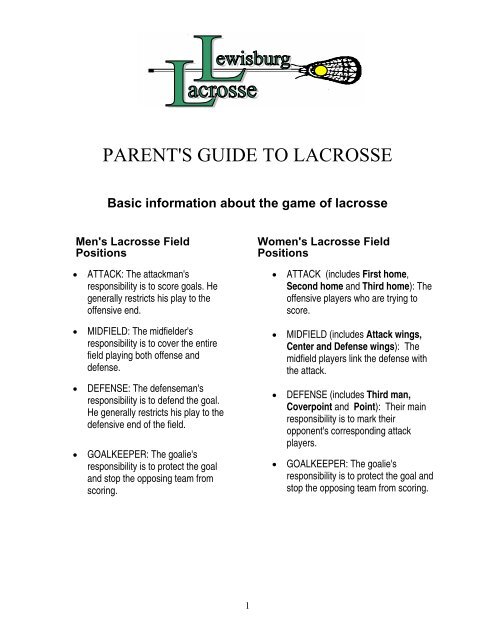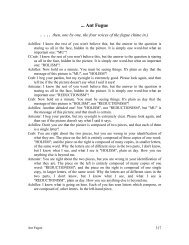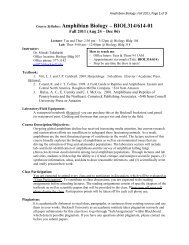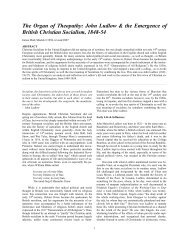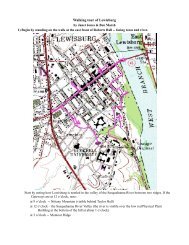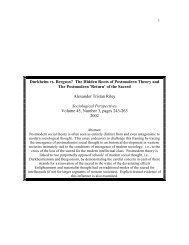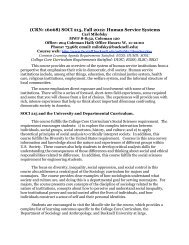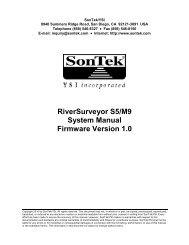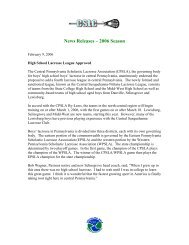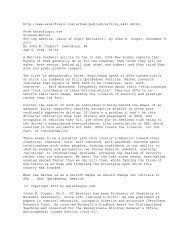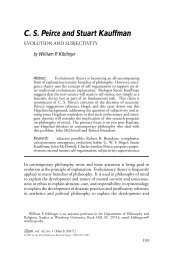PARENT'S GUIDE TO LACROSSE - Facstaff.bucknell.edu
PARENT'S GUIDE TO LACROSSE - Facstaff.bucknell.edu
PARENT'S GUIDE TO LACROSSE - Facstaff.bucknell.edu
Create successful ePaper yourself
Turn your PDF publications into a flip-book with our unique Google optimized e-Paper software.
<strong>PARENT'S</strong> <strong>GUIDE</strong> <strong>TO</strong> <strong>LACROSSE</strong><br />
Basic information about the game of lacrosse<br />
Men's Lacrosse Field<br />
Positions<br />
• ATTACK: The attackman's<br />
responsibility is to score goals. He<br />
generally restricts his play to the<br />
offensive end.<br />
• MIDFIELD: The midfielder's<br />
responsibility is to cover the entire<br />
field playing both offense and<br />
defense.<br />
• DEFENSE: The defenseman's<br />
responsibility is to defend the goal.<br />
He generally restricts his play to the<br />
defensive end of the field.<br />
• GOALKEEPER: The goalie's<br />
responsibility is to protect the goal<br />
and stop the opposing team from<br />
scoring.<br />
1<br />
Women's Lacrosse Field<br />
Positions<br />
• ATTACK (includes First home,<br />
Second home and Third home): The<br />
offensive players who are trying to<br />
score.<br />
• MIDFIELD (includes Attack wings,<br />
Center and Defense wings): The<br />
midfield players link the defense with<br />
the attack.<br />
• DEFENSE (includes Third man,<br />
Coverpoint and Point): Their main<br />
responsibility is to mark their<br />
opponent's corresponding attack<br />
players.<br />
• GOALKEEPER: The goalie's<br />
responsibility is to protect the goal and<br />
stop the opposing team from scoring.
Men's Lacrosse<br />
Lacrosse is played between two teams. The object of the game is to advance the ball into the<br />
opposing team's territory and shoot the ball into the opponent's goal. The team scoring the most<br />
goals at the end of regulation play is the winner. The ball is kept in play by being thrown,<br />
carried or hit by the stick, rolled or kicked by one or more players in any direction, as long as the<br />
ball stays in the field of play.<br />
A men's team consists of 10 players; 1 goalie, 3 defensemen, 3 midfielders and 3<br />
attackmen. Each team must keep at least 4 players, including the goalkeeper, in its defensive half<br />
of the field and 3 players in its offensive zone. The 3 midfielders are free to roam the entire field.<br />
The game has four quarters, plus a halftime. Teams change ends between quarters. Youth<br />
games are generally 32 minutes long, with eight minute quarters, two minute breaks between<br />
quarters and a ten minute halftime. High school games are generally 40 to 48 minutes long with<br />
either 10 or 12 minute quarters and 10 minutes at halftime. Collegiate games are 60 minutes long<br />
with 15 minute quarters and a 15 minute halftime. Each team is permitted 4 timeouts, with a<br />
maximum of two in a half of play, and one additional timeout per each overtime sudden victory<br />
period.<br />
The game starts at the center of the field with a face-off. Face-offs are also used to start<br />
each quarter and to resume play after each goal. The ball is placed on the ground and the two<br />
players facing off position their sticks back to back on either side of the ball, without touching<br />
the ball. The play starts when the official blows the whistle and face-off players and other wing<br />
midfield players try to control the ball.<br />
Players maneuver the ball by passing and/or running to gain an advantageous position<br />
which will provide opportunities for a player to score a goal. Only the goalkeeper may touch the<br />
ball with his hands.<br />
Players attempt to gain control of the ball by scooping or catching it with a stick or by<br />
dislodging the ball from an opponent's stick by checking. Checking involves poking, slapping or<br />
hitting an opponent's stick and gloved hand. Players may also attempt to gain possession of the<br />
ball by controlled body checks above the waist and below the shoulders from the front or side.<br />
Attacking players may never enter the area immediately around an opponent's goal,<br />
known as the crease. Nor may a player physically touch the goalie while the goalie is in the<br />
crease. Should the goalie gain possession of the ball, opposing players may try to block the<br />
goalie's outlet pass (the clear) by standing in the goalie's line of sight and waving sticks.<br />
Opposing players may also reach into the crease to try to retrieve loose or ground balls, but may<br />
not interfere with the goalie.<br />
Unlike other sports, should the ball go out of bounds after an unsuccessful shot,<br />
possession is awarded to the player closest to the ball where it went out of bounds at the moment<br />
the ball crosses the boundary line.<br />
The Men's Team<br />
There is no limit to the total number of players each team may carry on its roster. Most teams<br />
carry six to nine defensemen, six to nine attackmen, nine to twelve midfielders and three<br />
goalies. This provides three complete rotations of players (4 for midfielders). This is only a<br />
general rule of thumb and will vary considerably based on availability of players and coaching<br />
2
philosophy. There can be a maximum of four long sticks on the field at any one time (not<br />
including the goalie). The remainder must be short sticks.<br />
There will be situations (penalties) where one or both teams will be required to play with<br />
less than the full ten member team. These are typically known as Man Up (the unpenalized<br />
team) or Man Down (the penalized team) situations and are usually handled with special field<br />
formations. Upon issuance of a penalty, which requires one or more players to go to the<br />
"Penalty Box," substitutes are not permitted to take their place. The team must play with a<br />
r<strong>edu</strong>ced number of players until the penalized players are released back onto the field by the<br />
officials.<br />
The Men's Field<br />
The game is played on a rectangular field measuring 110 yards long by 53-1/3 to 60 yards wide.<br />
The field is marked at 55 yards from each end line with a center line and halfway across this<br />
centerline with an (X) to indicate the face-off zone (see Figure 1).<br />
Behind each goal there is a 15 yard space, and the goals are 80 yards apart. Twenty yards<br />
from each goal toward the center of the field there is a line called the defensive restraining line<br />
that spans the width of the field. The portion of the restraining line outside of the offensive box<br />
area is not shown in Figure 1.<br />
Goals are typically manufactured of steel or aluminum tubing, measuring 6 feet square at<br />
the widest opening and converging to a point 7 feet behind the opening. A mesh net is tightly<br />
secured to goal. Each goal sits inside a circle with a radius of 9 feet, called the crease. The<br />
center of each crease is on the goal line (15 yards from the end lines) and midway between the<br />
sidelines.<br />
OTHER IMPORTANT AREAS OF FIELD INCLUDE:<br />
• Goal Area – also known as the "offensive box." It is the area inside the restraining lines at<br />
each end of the field. The lines parallel to the sidelines are 10 yards in from the sidelines<br />
and are dashed to avoid confusion with the sidelines.<br />
• Defense Clearing Area - area behind the defensive restraining lines which run across the<br />
field 20 yards in front of the goal.<br />
• Wing Areas - indicated by two lines, 20 yards long and 10 yards in front of each sideline.<br />
• "The Penalty Box" Area - is located directly in front of the officials' table and is used as a<br />
holding area for players to wait out their penalties. Penalized players must remain in the<br />
box, down on one knee. It is also the access area for substitute players entering and exiting<br />
the field.<br />
3
Figure 1 Boys’ lacrosse field<br />
4
Men's Rules & Regulations<br />
The game of lacrosse is a contact sport. Rules have been established which are intended to<br />
protect the safety of the players and maintain control over the game. Each game at the varsity<br />
level must have a minimum of two officials, who are called the referee and the umpire. (Middle<br />
school games may have a single official. It is desirable to have two officials for a high school<br />
J.V. game.) There may also be a field judge and a chief bench official. Decisions regarding third<br />
and fourth officials are made by the organization hosting the game.<br />
It is the coach's responsibility to teach and instill in each player an understanding of the<br />
nature of the game – it is a physical contact sport, but uncontrolled violent acts must not be<br />
tolerated. Players must be trained and are required to play with mental and physical control.<br />
The NCAA and the NFHS (National Federation of State High School Associations) have<br />
put forth comprehensive regulations and penalties for infractions. Following is a brief summary<br />
of some of the major, common rule violations.<br />
PERSONAL FOULS are infractions of a serious nature, which carry suspension from the game<br />
for periods ranging from a minute to three minutes, depending on the severity and intent of the<br />
infraction. The penalty's length is usually one minute but can be up to three minutes at the<br />
discretion of the officials.<br />
Cross Check is a check by one player on another with the<br />
part of the stick between the player's hands.<br />
Slashing occurs when a player swings his stick at an<br />
opponent in a deliberate, vicious, or reckless fashion, or<br />
when the stick comes in contact with any part of the<br />
opponent other than on his stick or gloves, unless the<br />
opponent is actively attempting to deflect a legitimate<br />
check with part of his body. Slashing also occurs when the<br />
stick of a player strikes any part of an opposing player's<br />
body above the neck, unless when done by a player in the<br />
act of shooting, passing or scooping the ball.<br />
5
Illegal Body Checks occur when checking a player not<br />
within 5 yards of the ball, a late hit, contact from behind or<br />
above the shoulders or below the waist. This also occurs<br />
when a body check is thrown on an opponent who does not<br />
possess the ball, or when an avoidable body check of the<br />
opponent is made after the opponent has made a shot or<br />
pass.<br />
Tripping is obstructing an opponent at or below the waist<br />
with any part of the stick or body. If a player makes a<br />
legitimate check with the stick to dislodge the ball from an<br />
opponent's stick and subsequently the opponent trips over<br />
his own or the checker's stick, this is not tripping.<br />
Unnecessary Roughness occurs when a player uses unnecessary and deliberately violent<br />
contact on an opposing player or is excessively violent when holding or pushing.<br />
Unsportsmanlike Conduct occurs when a person who represents a team attempts to argue<br />
with or influence the decision of a game official, using threatening, profane, abusive, or<br />
obscene language or gestures during the game; or baits, taunts or acts in a manner considered<br />
unsportsmanlike by a game official.<br />
Illegal Crosse is the use of a crosse which does not conform to NCAA/NFHS rules and<br />
standards.<br />
Illegal Gloves are gloves which do not conform to required standards or when the glove's<br />
fingers and/or palms have been altered or removed.<br />
TECHNICAL FOULS are less serious than personal fouls and are subject to a 30 second<br />
suspension from play of the offending player (when the opponent is in possession of the ball) or<br />
loss of possession.<br />
6
Holding occurs when a player impedes or interferes with an<br />
opponent's stick movement.<br />
Off-Side occurs when there are more than six players on the<br />
opponent's side of the field. This also occurs when a<br />
defenseman crosses the center line as the ball is being cleared<br />
up the field and all three attackmen and midfielders have<br />
progressed past the center line.<br />
Warding Off occurs when a player with the ball uses his<br />
free hand or any part of his body to hold, push or control<br />
the stick or body of the player applying the check.<br />
Stalling is when a team intentionally holds the ball without<br />
advancing toward the goal.<br />
Screening (illegal pick) occurs when an offensive player moves into or makes contact with a<br />
defender with the purpose of blocking the defensive player from the opponent being played.<br />
7
Illegal Proc<strong>edu</strong>re is a term that includes touching of the ball by a player other than the<br />
goalie, playing in the game without a stick, use of illegal equipment, avoidable lateness of the<br />
team, placing a stick in an opponent's face, entering the game prior to expiration of a penalty,<br />
delay of game, more than 10 men on the field, and illegal playing out of bounds. (See<br />
complete description in NCAA rules).<br />
Interference occurs when one player interferes with the free movement of an opponent.<br />
Exceptions: when opponent has the ball and a player is within five feet of opponent, or the<br />
ball is loose or on the fly, and both players are within five feet of the ball.<br />
Pushing is when a player pushes, thrusts, or shoves an opponent from behind. Pushing is<br />
permitted from the front and sides when an opponent has possession of the ball or is within<br />
five yards of a loose ball.<br />
Equipment & Selection<br />
CROSSE - also known as stick.<br />
Crosse must be between 40 and 42" long for<br />
attackmen/midfielders and 52 and 72" long for<br />
defensemen. The head is to be 6½ to 10" wide.<br />
Goalie's crosse may be 10 to 12" wide. Younger,<br />
more inexperienced players, should use shorter<br />
sticks. Crosse contains three components:<br />
Shaft - made from a variety of materials<br />
including wood, metal or plastic. Most common<br />
is aluminum and its alloys. Aluminum and metal<br />
alloy shafts are the most popular for their relative<br />
strength and light weight.<br />
The length of the shaft should grow with a<br />
player's size, development and skills. When<br />
selecting a shaft, the most important point to consider is how it feels in a player's hands.<br />
Younger, more inexperienced players need to concentrate on feel and weight, not on<br />
materials of construction. Strength of shaft becomes critical with older, stronger, more<br />
experienced players.<br />
Head - its sole purpose is to act as a frame for the pocket. The head can be made of wood,<br />
plastic, or other synthetic material. The most common is plastic, because of its strength and<br />
lightness. There are a wide variety of heads available. It is best for beginners and younger<br />
players to stay with basic, simple heads.<br />
Pocket - net that forms a pocket in which the ball is carried and cradled and from which the<br />
ball is thrown. The pocket is the single most important and controllable part of the crosse. It<br />
is very important that players get to know their pockets and how to adjust them. A player<br />
8
with average equipment, but good stick skills, and a good feel for the pocket will always<br />
perform better than a player with expensive equipment and average skills. Pockets come in<br />
two types: Traditional and Mesh<br />
Traditional - consists of four leather thongs, around which are interwoven synthetic cord<br />
and shooting strings. This produces a more accurate pass and shot, making it<br />
easier to control and absorb the ball. Major drawback: it takes time to soften the<br />
leather and form the proper pocket.<br />
Mesh - a single piece of open nylon mesh material which is stretched between the sides<br />
of the head and attached with nylon cord, through which shooting strings run.<br />
This forms a good pocket immediately, is durable, and easy to adjust. This<br />
pocket is more forgiving while learning the basics and is preferred for those just<br />
starting the game.<br />
Shooting Strings are made of heavy duty shoelace material, which are interwoven across the<br />
pocket. The purpose is to form a release point of the pocket. The actual pocket is formed<br />
just below the last shooting string. The objective is to form a short, smooth path for the ball<br />
to travel out of the stick.<br />
The pocket must be adjusted so that the top of the ball does not fall below the bottom edge<br />
of the head when the stick is held horizontally. The purpose of this rule is so a player can't<br />
make it difficult for an opponent to dislodge the ball with a check.<br />
For safety purposes, all sticks are to have a plastic or wood plug covering the end of the<br />
stick opposite the head. Sticks are not to be physically bent or altered, other than material<br />
added on the exterior surface for improved grip and weight.<br />
THE BALL is white, yellow, or orange and is made of solid rubber. The ball is 7¾ to 8" in<br />
circumference and weighs 5 to 5¼ ounces.<br />
HELMET - Each player is required to wear a protective helmet that includes a metal face mask<br />
with a chin pad, and a cupped four point chin strap fastened at all points to the helmet. All<br />
helmets and face masks should be NOCSAE (National Operating Committee on Standards<br />
for Athletic Equipment) approved.<br />
The fit is the most important point to consider when selecting a helmet.<br />
MOUTHPIECE - Must be a highly visible color and worn at all times while on the field.<br />
GLOVES, SHOULDER PADS, SHOES, AND JERSEYS are required protective equipment<br />
for all regulation games.<br />
Style and type of gloves and shoulder pads is optional, but is restricted to those approved<br />
for use in this sport. Type of shoe is optional, however, hard rubber cleats are<br />
recommended.<br />
9
The most important considerations when selecting gloves is fit and position. The player<br />
must be able to get a good grip, be able to feel the shaft through the gloves and be able to<br />
control the stick.<br />
Shoulder pads need to fit well. Points to consider when fitting a player are size and weight.<br />
Younger players typically require more protection than older, more experienced players.<br />
Middies and attackmen usually require more protection because of the frequency and the<br />
force of checks being thrown against them. Defensemen need less protection. Goalies must<br />
wear all required equipment, including a throat protector and chest pad. Optional equipment<br />
for goalies are leg and shin guards. All players need the most protection possible without<br />
being uncomfortable or weighted down.<br />
PROTECTIVE ARM AND RIB PADS, ATHLETIC SUPPORTERS AND PROTECTIVE<br />
CUPS are required by CSLC for player safety. Many leagues have made these items<br />
required equipment.<br />
10
Women's Lacrosse<br />
(adopted from Parent's Guide to the Sport of Lacrosse, 6 th ed. and Women's Rules 2007, both<br />
published by US Lacrosse)<br />
Girls' lacrosse is a non-contact sport played between two<br />
teams. The object of the game is to advance the ball into the<br />
opposing team's territory and shoot the ball into the opponent's goal.<br />
The team scoring the most goals at the end of regulation play is the<br />
winner.<br />
The field is approx. 60 yards wide and 110 yards long. There<br />
is also a restraining line 30 yards up field from each goal line, which<br />
extends across the entire width of the field. No more than 7 field<br />
players may be between the restraining line and their opponent's<br />
goal at any time (see Figure 2).<br />
Goals are placed at a distance of at least 90 yards apart, and<br />
play behind the goal is allowed. Each goal sits inside a circle (called<br />
the goal circle or crease) which has a radius of 8½ feet. Only one<br />
player, either the goalkeeper or her deputy (a field player who<br />
temporarily stands in her position), is allowed in the goal circle at<br />
any one time. No other player or any part of her body or stick may enter the crease at any time.<br />
The collegiate game is 60 minutes long (two 30-minute halves), while the high school<br />
game is 50 minutes long (two 25-minute halves). In both collegiate and high school play, teams<br />
are allowed two timeouts per game. Teams change ends at halftime. Substitution may be “on the<br />
fly” or following a goal, injury, time out, or half.<br />
The game begins with a draw (called a face-off in men's lacrosse). Two players (the<br />
centers) hold the ball between their back-to-back sticks (a stick is also called a crosse) at waist<br />
height at the center of the field. Four other field players stand at the edge of the center circle,<br />
which is 18 meters in diameter. At the sound of the whistle, the ball is flung into the air as the<br />
sticks are pulled up and away. The ball must be flung higher than the heads of the players taking<br />
the draw. Either player taking the draw, or any other field player, may take possession of the ball<br />
after the draw. A draw is used to start each half and to resume play after each goal.<br />
There are 12 players on a team: three attack players (called 1 st home, 2 nd home, and 3 rd<br />
home), five midfielders (called left and right attack wings, left and right defense wings, and a<br />
center), 3 defenders (called 3 rd man, cover point, and point), and one goalkeeper (see Figure 3).<br />
Field players may pass, catch, or run with the ball in their crosse. If the ball is dropped, it<br />
may be scooped up with the crosse (a player may not pick up the ball with her hand). The ball<br />
may not be kicked or played off the body to gain an advantage. The ball may not be trapped<br />
under the crosse or raked back.<br />
A player may gain possession of the ball by dislodging it from an opponent's crosse with<br />
a check. A check is a controlled tap with a crosse on an opponent's crosse to try to knock the ball<br />
free. The player must be one step in front of her opponent in order to check and the check must<br />
be away from a 7-inch "sphere" around the head. A check is considered illegal if the defender<br />
reaches across her opponent's body when she is level with or behind her, if the defender checks<br />
inside her opponent's sphere, or if the check is rough or reckless. Absolutely no contact to the<br />
body with the crosse or body is allowed.<br />
11
When a whistle blows, all players must stand in place. When a ball is ruled out of bounds,<br />
a player on the team that did not have the last possession gets the ball when play is resumed.<br />
When the ball goes out of bounds on a shot, the player closest to the boundary when the ball goes<br />
out of bounds gets a free possession 4 m inside the boundary.<br />
Fouls are categorized as major or minor, and the penalty for fouls is a "free position." For<br />
major fouls, the offending player is placed 4 meters behind the player taking the free position.<br />
For a minor foul, the offending player is placed 4 meters off, in the direction from which she<br />
approached her opponent before committing the foul, and play is resumed. If a check makes<br />
contact with a player's head or slashing occurs in the field of play, the whistle is blown<br />
immediately, and a yellow (warning) or red (suspension) card is given. A player receiving a<br />
yellow card must leave the field for 3 minutes of elapsed playing time, but a substitute may take<br />
her place. A player receiving a red card is suspended from further participation in that game, but<br />
a substitute may take her place. If a team receives more than 3 yellow or red cards in a game, no<br />
substitute is allowed for the carded player for 3 minutes and the team plays short.<br />
Special rules apply inside the 8-meter arc and the so-called critical scoring area. If the<br />
defensive team commits a foul in this area, the official may raise her flag indicating a foul, but<br />
hold the whistle ("slow whistle") to give the offensive team an opportunity to score a goal. If the<br />
offensive team loses the advantage, they are given either a direct free position (the official clears<br />
a penalty lane to the goal) or an indirect free position (the player taking the indirect free position<br />
may not shoot until the ball has been played by some other player). An immediate whistle is<br />
blown when a major foul is committed, which jeopardizes the safety of a player.<br />
Major and Minor Fouls<br />
Major Fouls<br />
Blocking occurs when a defender moves into the path of an opponent with the ball without<br />
giving that player a chance to stop or change direction.<br />
Charging occurs when a player with the ball pushes into, shoulders, or backs into an opponent<br />
who has already established her position (though not necessarily stationary).<br />
Dangerous shot occurs when a player throws the ball toward the goal without control, or in the<br />
direction of a field player or the goalkeeper.<br />
Misconduct occurs when a player conducts herself in a rough, dangerous, or unsportsmanlike<br />
manner, persistently breaks the rules, or deliberately endangers the safety of opposing players.<br />
Slashing occurs when a defender swings her crosse at an opponent's crosse or body with<br />
deliberate viciousness or recklessness, whether or not the opponent's crosse or body is struck.<br />
Three seconds. A defender may not stand within the 8-meter arc, unless she is closely marking<br />
an opponent, for more than 3 seconds.<br />
12
Obstruction of free space occurs when a defender is not closely marking her opponent and is in<br />
the free space on the goal side of the attack player with the ball. The attack player must have the<br />
opportunity and be looking to shoot.<br />
Minor Fouls<br />
Goal circle fouls occur when any part of an offensive or defensive player's body or crosse,<br />
except that of the goalkeeper or her deputy (a field player who temporarily stands in her<br />
position), enters the crease.<br />
Warding off occurs when a player guards a ground ball with her crosse or foot, removes one<br />
hand from the crosse and uses her free arm to ward off an opponent, or checks an opponent's<br />
empty crosse while she is trying to get possession of the ball.<br />
Empty crosse check. A player may not check an opponent's crosse unless the ball is touching<br />
the opponent's crosse.<br />
Body ball. A ball that hits a field player's body to her distinct advantage.<br />
The umpire's arm signals for these fouls are shown in Figure 4.<br />
Field Positions<br />
The Attack<br />
First home. The first home's responsibility is to score. Located in front of the goal, the first<br />
home must continually cut toward the goal for a shot, or cut away from the goal to make room<br />
for another player. She should have excellent stickwork.<br />
Second home. The second home is considered the playmaker. She should be able to shoot well<br />
from every angle and distance from the goal.<br />
Third home. The third home's responsibility is to transition the ball from defense to attack. She<br />
should be able to feed the ball to other players and fill in wing areas.<br />
The Midfield<br />
Attack wings. The wings are also responsible for transitioning the ball from defense to attack.<br />
Wings should have speed and endurance and be ready to receive the ball from the defense and<br />
run or pass the ball.<br />
Center. The center's responsibility is to control the draw and play both defense and attack. She<br />
should have speed and endurance.<br />
Defense wings. The wings are responsible for marking the attack wings and bringing the ball<br />
into the attack area. Wings should have speed and endurance.<br />
The Defense<br />
Third man. The third man's responsibility is to mark her opponent's third home. She should be<br />
able to intercept passes, clear the ball, run fast, and have good footwork.<br />
Coverpoint. The coverpoint's responsibility is to mark her opponent's second home. She should<br />
be able to receive clears from the goalkeeper, run fast, and have good footwork.<br />
13
Point. The point's responsibility is to mark her opponent's first home. She should be able to<br />
stick check, body check (to follow each movement of her opponent's body with her body to<br />
cause her to slow down, change direction, or pass off; no actual body contact may take place),<br />
and look to intercept passes.<br />
Goalkeeper. The goalkeeper's responsibility is to keep the ball out of the goal. She must have<br />
tremendous concentration and confidence. She is also an important element in the defensive unit<br />
because she can watch the game and warn her defense about the position of the ball and<br />
opponents who pose a possible scoring threat. She must have a loud voice and communicate<br />
well with her defense.<br />
Equipment<br />
Crosse (Stick)<br />
Made of wood, laminated wood, or synthetic material, with a shaped net pocket at the end. A<br />
girl's crosse must be between 35½ and 43¼ inches long overall. The head of the crosse must be<br />
between 7 and 9 inches wide. The pocket of the crosse must be traditionally strung (no mesh).<br />
The top of the ball when dropped in the pocket must remain even with or above the side walls.<br />
The goalkeeper's crosse may be 35½ to 48 inches long. The head of the crosse may be mesh and<br />
up to 12 inches wide. The umpire will inspect all players' sticks before the game begins. At any<br />
time during the game, at the umpire's discretion, time out may be called to re-inspect the<br />
equipment.<br />
The ball<br />
The ball must be yellow and made of solid rubber. The ball must be 7.75 to 8 inches in<br />
circumference and weigh 5 to 5.25 ounces.<br />
Field players’ equipment<br />
All field players must wear ASTM-approved goggles and a mouth guard. Any color mouth guard<br />
except white and clear is acceptable. There may be no protruding tabs for field players.<br />
Close-fitting gloves, nose guards, soft head gear and eye guards are optional, and may be worn<br />
by all players.<br />
The goalkeeper's equipment<br />
The goalkeeper wears a helmet with a face mask and separate throat protector, a mouth guard, a<br />
chest protector, padded pants, shin guards, and gloves. The goalkeeper’s stick is larger than the<br />
field players’ sticks.<br />
Jewelry<br />
Players may not wear jewelry on the field except for Medic-alert jewelry with information<br />
visible, which must be taped securely to the player. Barrettes are legal as long as they do not<br />
endanger other players. The umpire has the power to rule any decoration as dangerous to other<br />
players, to remove it from the field, and to penalize it as a minor foul.<br />
14
8-meter arc<br />
12-meter fan<br />
Restraining line<br />
Restraining line<br />
Figure 2 Women's field dimensions<br />
15
Figure 3 Women's field positions<br />
16
Figure 4 Visual arm signals for umpires in women's lacrosse<br />
17


